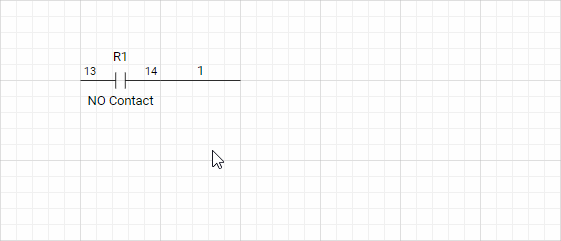Symbols and Components
Symbols with multiple forms
On some occasions, you may want to create drawings that display symbols horizontally. At other times, you may want to create vertical ones. Capital X Panel Designer makes it easy to do both, with one single symbol.
Symbols in Capital X Panel Designer are intelligent, and can be rotated vertically or horizontally with a simple right click. Rotated symbols automatically have their text and descriptions moved to the correct positions.
Drop a symbol onto a drawing and right click for more options.

Symbols that works irrespective of units
Symbols in Capital X Panel Designer are also unit agnostic. This means that you can create a single symbol and use it on multiple page measurement units including inches, millimeters, centimeters and meters, where Capital X Panel Designer will automatically resize your symbols so that they fit nicely on whatever units you have chosen.
How to duplicate symbols and wires
In electrical drawings, you would have to duplicate circuits, symbols and wires. To easily duplicate, select shapes with your mouse, and simply press the CTRL key, then drag and drop.

In addition, you can also select shapes, and press CTRL-C to copy, CTRL-X to cut and CTRL-V to paste.
Intelligent automatic numbering
All symbols will be automatically and intelligently named when placed or duplicated on a drawing.
For symbols dropped from a stencil, Capital X Panel Designer will follow the naming format during symbol creation. For example, when you create a symbol and called it C1, then Capital X Panel Designer will name it C1, C2, C3, etc when you drop them onto your drawings.
For duplicated symbols, Capital X Panel Designer will follow the existing format on the symbol. For example, when you dropped a symbol called C1 onto a drawing, and then renamed it Control1. When you duplicate Control1, Capital X Panel Designer will name subsequent symbols Control2, Control3, etc, all automatically.

Automatically assigning pin names
Capital X Panel Designer automatically assigns the next available pin set when symbols share the same references.

Users can right click on a symbol and select Set Pin Names to manually assign another pin set or to show/hide pin names.

In addition, you can click on Properties | Layers, and modify the Pins layer to show or hide pin names for the entire page.
How to assign and manage components
Users can assign and manage components by clicking on Manage Components.
Symbols in Capital X Panel Designer are organized by references and then divided into groups. Each group can then be assigned to one or more real world component. These assignments will then be used in generating layout, bills of materials and reports.

Understanding the component database
The Component Database stores all component specifications so that they can be used and re-used on multiple projects and drawings. Once a component is selected, it's specifications is then transferred and stored on the drawing itself for portability.
Components stored on the database are divided into categories and a single component can appear in more than one category. Users can click Component Database, to add, edit or delete components from the database. In addition, the entire database can be exported for editing, and imported back into Capital X Panel Designer.

How to make your own symbols
To create your own symbols, first draw your own graphics and text.

If you have multiple shapes, group them all and add connection points.

Click on Create Schematic Symbol, and fill in required information, then click OK.
During symbol creation, Capital X Panel Designer will ask users for a category. This category will then be used during component management where only components with the same category is initially presented to the user.
For example, if a symbol is assigned to the "Motor" category, during component management, only motors will be initially presented. Users can then select a component from the same category or select another one from a different category. Categories are used to facilitate easier component management and selection.
When creating symbols, a default component will be assigned to the symbol. For example, a motor symbol will be assigned a default motor component. Users can override this default and choose the required component later using Manage Components.

How to assign pin names to symbols
When creating symbols, users can set pin names using the Set pin names dialog, including setting the position of the text and it's orientation.

How to see location of symbols using AutoLocation
The AutoLocation symbol displays the location of your references automatically in real time, all without user interference. Autolocation will update automatically when you move symbols, even across multiple pages.
Right click on an AutoLocation shape to jump to monitored references. Multiple AutoLocation symbols can be used to monitor the same reference on multiple pages.